Cite this document
(“Key Words in Marketing (Customer Relationship Management) Essay”, n.d.)
Key Words in Marketing (Customer Relationship Management) Essay. Retrieved from https://studentshare.org/management/1496302-key-words-in-marketing-customer-relationship
Key Words in Marketing (Customer Relationship Management) Essay. Retrieved from https://studentshare.org/management/1496302-key-words-in-marketing-customer-relationship
(Key Words in Marketing (Customer Relationship Management) Essay)
Key Words in Marketing (Customer Relationship Management) Essay. https://studentshare.org/management/1496302-key-words-in-marketing-customer-relationship.
Key Words in Marketing (Customer Relationship Management) Essay. https://studentshare.org/management/1496302-key-words-in-marketing-customer-relationship.
“Key Words in Marketing (Customer Relationship Management) Essay”, n.d. https://studentshare.org/management/1496302-key-words-in-marketing-customer-relationship.


